FITZ BALINTINE PETTERSBURG – THE ROYALPARCHMENT SCROLL OF
BLACK SUPREMACY - 1925
This book is essential for
reasons that have not been seen at the time and are still obscure today because
most people look at such attempt at creating a new religion as futile and
useless, if not plainly childish or delinquent: making money from the gullible
audience. The fact that this document and the religion it contains target the
black audience does not change this financial and commercial objective. But that
is too simple to reject something without analyzing it at all because of its
commercial dimension;
First it was written in 1925,
when Marcus M. Garvey, to whom the book refers several times as a general or a
prophet, was in prison in Atlanta,
Georgia at the time and he will come out of it only in 1927 when his five year
sentence will be commuted by IUS President Coolidge to deportation to Jamaica,
which meant he could never come back to the USA.
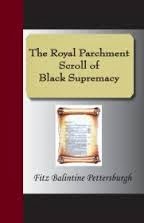
In other words some followers,
and maybe some sharks, were taking advantage of the absence of the leader of
the Universal Negro Improvement Association (UNIA) from the public scene to
reach out and set up a new organization that would have a religious basis,
knowing that Garvey’s constant reference to Jesus was no lip service but it was
no affiliation either to any church at all. The point is important here. All
Christian churches were originally European, hence white, and based on a sacred
book that was interpreted as stating the racial affiliation of Jesus and all
other characters from Adam onwards in the book as being white, including God to
whose image man was created. We could have thought they might have moved away
from this biblical reference, and in fact they did not.
The biblical reference is just
hijacked and the white interpretation is rejected under the “name” of
Adam-Abraham-Anglo-Saxon Anarchy which is Antediluvian and has nothing to do
with what this document states as the reality. In fact Adam is nothing but a
thief who stole an apple from the Tree of Life that the King of Kings in this
document pretend to be the defender of, a fornicator along with Eve, the mother
of all Evil, who is a harlot. And Abraham and Isaac are rejected because they
do not have a book in the Old Testament. In other words they are fakes and
usurpers.
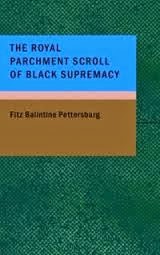
The creation is said as being the
result of a supreme and original divinity that invented theology and gave birth
to King Alpha and Queen Omega, the eternal couple of sovereigns to rule the
world, King Alpha being the King of Kings. You will find some contradictory
elements in the document about this affiliation. The reference to the alpha and
the omega is taken from Revelation
22:13: “I am the Alpha and the Omega, the First and the Last, the Beginning and
the End.” This reference is in itself surprising when we know that Jesus and
all the other characters in the old Testament before Jesus’ New Testament spoke
and wrote some Semitic language, Hebrew or Aramaic, for two of them, languages
that could not have a letter corresponding to omega, and certainly not as the
last one since omega is a vowel and Semitic language only have one vowel in
their alphabet, aleph in Hebrew, which is written only when it is at the
initial of a root like Adam: ADM derived from the word meaning earth adamah,
ADMH. Otherwise vowels are not written as letters. It is all the more
surprising to find this reference in this document because of the next
assertion.
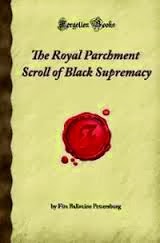
The author considers Ethiopia as being the cradle of
this humanity with a possible alliance between this Black Ethiopian God or King
of Kings with the Egyptian Pharaoh captured as a woman. I must say the passage
is not that clear when we read over and over the absolutely procreative
approach of couples that have to be heterosexual and come across this
assertion: “At the Banquet in Egypt,
King Solomon, The Black Man, made Love, with King Pharaoh, The Black Man’s
Virgin princess.” (Chapter 23) Solomon and David are the only references in the
Old Testament that the author of this document consider authentic, and he sees
them as black, and here Solomon has interesting relationships with Pharaoh,
though of course he is sexually paired with the black queen of Sheba in another
passage. Of course Solomon and Pharaoh are understood as symbols of the Black
Man and the Black Woman, but even so.
What is essential here is how the whole identity of this
God of the Bible is entirely made black and the Virgin that gave birth to Jesus
is of course the Black Virgin, hence Jesus was black. The objective is to
rebuild the Temple of Solomon in Ethiopia but a lot grander and
bigger.
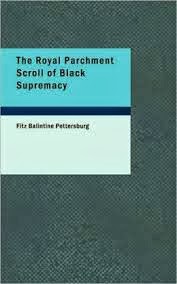
The central principle is that of Black Supremacy and it is
attached to the UNIA and Marcus Garvey. This Black Supremacy is paired with a
total rejection of White Supremacy that had put Africa
into slavery. The fate of the white race is not clear: will it be eliminated,
exterminated or just side-tracked? It is not really and clearly said. What is
said is that black men and black women are supposed to have absolutely no
intercourse with white women and white men, respectively. Behind this black
supremacy we meet with the principle of race purity that is so dear to Marcus
Garvey. Of course the ban on sexual relations between men and women of the two
races has to be understood as covering any gay or lesbian temptation. It goes
without saying.
The point here is to interpret this rewriting of the Bible
in “sable hue.” The black slaves were free Africans before the arrival of
Europeans, or Africans that could be captured and sold as slaves to the Islamic
world in northern Africa, from which they
could redeem themselves. They were captured by African slave-dealers but
starting at the beginning of the 16th century they were sold to
Europeans who took them to America.
They could not imagine what was going to happen to them. That slavery became a
tremendous trauma that lasted for three hundred years in the USA where it
lasted longest, at the very least ten or twelve generations. That slavery was
defined by people like Willie Lynch as the transformation of an African savage
into a docile slave who stood on the ladder of farm possessions, under horses
and over oxen and cows. Strangely enough the Trauma was so deep that it got
integrated 100% by Garvey and the author of this document, so deeply integrated
that the only possible escape from it was to claim absolute racial purity and
total reversal of domination, with Garvey being slightly more prudent and
asserting the total racial separation as an obligation in the modern world.
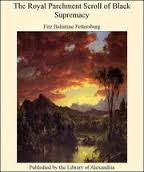
In other words these intellectuals, or militants, have
integrated the Post Traumatic Slavery Syndrome or Disorder of the descendants
of slaves so perfectly that it is taken as the starting block from which the
future will have to be built without any rejection and the only solution can be
the inversion of the evil the black Africans suffered when brought to America,
at least those who survived the passage.
That explains the style of this document. The author is in
many ways delirious, entirely possessed by some kind of irrational vision that
enables him to assert anything that fits his own phantasmagoric constructions.
Paul Radin identifies this mental state of the religious man in The World of Primitive Man:
“. . . his temperamental make-up, one in which. . . we are
dealing with individuals whose psychical unbalance and whose psychical crises
are continuously present. . . He possesses a temperamental predisposition which
frequently places him in the neurotic-epileptoid group.” (p. 79 & 94)
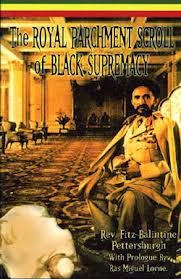
But those who approach this religious construction as being
nothing but a commercial trap for mentally-underdeveloped people are totally
mistaken. This religious discourse is going to be a founding stone of Rastafari
ideology that will later produce Reggae music and culture. The blue ribbon and
county fair medal in this type of misinterpretation of this movement should be
given to Jérémie Kroubo Dagnini from Bordeaux, France, in his article “Marcus Garvey: A Controversial Figure in the
History of Pan-Africanism” who reproaches Marcus M. Garvey with not using the
local Jamaican Creole, Patois, and dressing in western style clothing instead
of African traditional clothes. That is refusing to see the phenomenally cruel
and inhuman deculturalization the African slave has been obliged to go through to survive and
then to develop in his or her children for them to be able to survive to some
kind of adult age. Marcus Garvey is entirely possessed by the Post Traumatic
Slavery Syndrome that all African slaves and descendants have suffered, and the
present document is just the best expression of it: the black author is making
the forced Christianization that was eventually imposed onto all black slaves
into the corner stone of his racial black supremacy by simply making the white
characters of the story black.
That’s why we need such documents
because they are the evidence of the PTSS of the descendants of slaves more
than 50 years after emancipation.
Dr Jacques COULARDEAU
# posted by Dr. Jacques COULARDEAU @ 8:51 AM
0 comments

VAUGHN BODÉ – DĂS
KÄMPF – 1963 – JEAN-PAUL GABILLIET – 2013
La première remarque à faire est que le livre est entièrement bilingue. En
français à partir de la première de couverture et en anglais à partir de la
quatrième de couverture. La postface de Jean-Paul Gabilliet est elle aussi en
deux langues et a été traduite en anglais par Alexis Pernsteiner. Je ne dirai
rien de cette traduction. Par contre je n’ai trouvé aucune part, dans les pages
de copyright par exemple où cela devrait être mentionné, l’auteur de la
traduction des légendes de la « bédé ». Je crois savoir qu’elle est
de Jean-Paul Gabilliet. Si je me trompe autant pour moi.
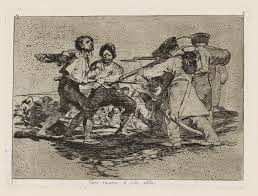
Cette traduction d’ailleurs est souvent plus guindé que l’original car le
ton n’est pas conservé entièrement. En effet l’utilisation par exemple de la deuxième personne qui peut être
du singulier comme du pluriel en anglais construit une référence personnelle en
fait non référentielle, j’entends ne référant pas à la personne singulière, ou
plurielle d’ailleurs, à laquelle les dessins s’adressent, le ou les lecteurs. Cette
deuxième personne en fait réfère au soldat singulier du dessin qui subit la bêtise
de la guerre, mais en lui donnant une valeur plurielle et donc a-personnelle,
impersonnelle, générique. C’est vrai pour tout soldat. L’utilisation du
singulier « tu » en français, tue, c’est le cas de le dire, cette
dimension générique. Le traducteur l’a senti d’ailleurs car dans certains cas
il préfère une troisième personnelle singulière impersonnelle et donc générique
d’où un ton plus guindé que l’original.
On pourrait pousser plus loin car parfois il fait l’inverse comme page 36 :
« WAR is being awful tired
and wanting to go home – so you do… »
qui devient en
français :
« LA GUERRE, c’est quand t’es crevé et que tu veux rentrer chez toi…
et que tu rentres chez toi… »
Je ne peux rien dire sur l’article devant GUERRE car il est de droit si j’ose
dire, bien qu’il enlève l’adresse directe, le coup de poing que le nom anglais
sans article porte en lui. Mais on perd ici la force de « awful »
adjectif employé en adverbe et que le traducteur intégre à l’adjectif en
utilisant « crevé » au lieu de « fatigué » mais cela
enlève la double rythmique trochaïque remplacée
par deux syllabes non accentuées bien sûr puisqu’on est en français. Les
trochées anglais sont une rythmique inversée de la rythmique naturelle et la
plus courante et dynamique de l’iambe. Ici ces trochées donnent une sorte d’impression
d’essoufflement, donc de grande fatigue.

Traduire « to go home » par « rentrer chez toi » pose
deux problèmes : d’une part « home » (« sweet home »
bien sûr) est effacé et j’aurais préféré « rentrer à la maison » sans
compter qu’alors j’aurais ainsi gardé la non référence personnelle, donc l’impersonnel,
alors que Jean-Paul Gabilliet cataphoriquement rajoute une référence de
deuxième personne du singulier, incité en cela par cette référence qui est
générique comme je l’ai dit dans « so you do… » Mais la dimension
générique de ce « you » anglais est perdue au profit d’une dimension
d’adresse personnelle au lecteur de la légende.
La répétition de « rentrer chez toi » enlève la dimension
automatique, non planifiée, non voulue, simplement réflexive (de l’ordre du
réflexe) de l’anglais « – so you do… » On notera le tiret remplacé
par les trois points de suspension. La valeur sémantique des deux n’est pas la
même, le tiret anglais impliquant qu’il n’y a aucune réflexion et l’automatisme
de l’ordre du réflexe non réfléchi est bien sûr fortement porté par le « so »,
reprise anaphorique de « go home ». On me dira que cela est
intraduisible. Certes mais traduire « home » par « maison »
aurait ajouté en français le subtilité de E.T.
qui pointe son doigt vers son étoile et dit « home » et la version
doublée dit « maison ». Je ne proposerai rien ici. Personnellement je
ne traduirais pas un texte de ce genre. Je ne m’appelle pas Google ou Reverso
qui ont la prétention de tout traduire.

La postface est honnête et donne les éléments factuels nécessaires pour
comprendre. Mais je n’ai pas trouvé la référence que j’attendais à Mad Magazine qui a largement fait dans
le genre caustique, antipolitique, antimilitariste, anti-establishment depuis
1952. J’attendais aussi la mention d’Art
Spiegelman et de sa « revue » RAW qui en grande partie hérite
du travail de Vaughn Bodé. Mais il y a d’autres précurseurs et d’autres
héritiers.
Que dire ce cet « humour » noir et caustique sur la guerre qui en
montre l’absurdité logique ou la logique absurde. Goya lui avait fait dans la
barbarie cruelle ou la cruauté barbare. Je regrette aussi l’absence de ces
dessins, croquis, esquisses, estampes, « bédé » avant l’heure des « Désastres
de la guertre ».
C’est un peu comme quand un colonel pendant des manœuvres (tirs à blanc)
inspecte le « front » sans avoir mis les plastrons et brassards
blancs spéciaux pour les observateurs et qui se plaint ensuite qu’un appelé (cela
se faisait encore en ce temps-là) tire que le colon « à blanc »
certes mais à portée de flamme (la poudre de la balle à blanc brûle bien sûr et
produit une flamme d’environ un mètre cinquante ou deux.
Ce serait un lieutenant dans des manœuvres qui donne l’ordre de jeter les
bombes fumigènes sur la route devant son char sans réaliser que le vent lui
souffle dans le visage, ce que l’appelé (cela existait autrefois) futé a remarqué
et jette donc avec jubilation une fumigène d’un kilo deux mètres devant le char
que le lieutenant, sorti des écoles militaires s’il vous plait, doit faire
déplacer d’urgence.
Faites les mêmes choses en, guerre réelle et non en manœuvre et vous avez
Vaughn Bodé. C’est d’ailleurs pourquoi la suppression du service militaire a
été une catastrophe humoristique pour le commun des mortels qui savait prendre ses
pieds dans bien du plaisir avec les sottises de certains jeune officiers
inexpérimentés ou de certains vieux officiers engoncés dans leurs souvenirs de
guerre réelle, comme la Guerre d’Algérie.
« GUERRE : C’est quand on met un rat affamé sous un casque lourd
sur le bas-ventre, génital bien sûr, d’un Arabe uniquement vêtu de ses poils. »
Je vois le dessin d’ici, y compris avec la tête de l’adjudant qui ne
manquait jamais l’occasion de raconter son histoire à une PFAT innocente
(Personnel Féminin de l’Armée de terre) fraîchement arrivée à la CAR N°1 de
Rueil Malmaison.
Dr Jacques COULARDEAU
# posted by Dr. Jacques COULARDEAU @ 8:56 AM
0 comments

LAUTNER – AUDIARD
– LES TONTONS FLINGUEURS – 1963
C’est un film culte de son époque, juste après la fin de la guerre d’Algérie. Et cela ne pardonne
pas, pas le moins du monde. On a donc droit aux acteurs en vogue à l’époque
dans les rôles de durs, et ceux qui jouent plutôt dans le roublard vicieux et
enfin une actrice, et cela suffit dans ce milieu illicite et interlope qui joue
à la fausse naïve totalement faussement innocente.
On n’en finit donc pas de mettre les durs à la botte de leur chef
nouvellement promu par leur chef défunt. Ils veulent tous faire la banque et se
barrer en se beurrant le fond de poche, sinon prendre la succession à condition
de liquider le trouble fête. Alors c’est la guerre et il passe plus de balles
sur l’écran que de mouettes dans le port de Brest.
Vous y découvrez un Paris vide de voitures, des Champs Elysées totalement
désertés à cinq heures du matin, une église de quartier dans Paris est dont on
ne nous montre pas le cimetière juste derrière, un lieu de tout repos pour gens
aimant le silence, on nous impose u n peu de musique moderne de ce temps-là, un
délice grinçant, du twist pour la bonne cause, un président du Fonds Monétaire
International sourd et peut-être aussi aveugle, j’entends, et de la bonne
oreille, celle qu’il me reste alors que deux sont déjà patraques, qui n’ entend
que le bruissement des billets de banque et ne voit que les liasses des mêmes.
Amusant comme remise en ordre des affaires interloquantes de ce Paris de
1963. Et ils tombent les uns après les autres. Les camions brûlent, les voitures
explosent, d’autres se retournent, on reçoit une bombe en cadeau d’anniversaire
qui vient comme un cheveu sur la soupe et des poils sur une mamelle de vache.
Et je ne dirai rien des embouteillages, j’entends la mise en bouteille d’alcool
au moins frelatée dans des bouteilles tout ce qu’il y a de plus clandestin.
Vive le pastis de contrebande : il monte facilement à 75 degrés.
Vous jouirez des DS de l’époque, de ces crapauds de la route, de ces
grenouilles de boulevard et à l’horizon pas une seule grenouille de bénitier,
un prodige pour un film français Vous ne
pourrez pas y manger le moindre petit curé. Ils ont tous viré leur cuti et se
retrouvent tous sur les bancs du catéchisme, mais je ne donnerais la communion
à aucun de ces messieurs car ils ont tous un air louche ou écumoire qui me fait
froid droit dans le dos.
C’était le temps où les effets spéciaux étaient très réduits et il fallait
donner l’illusion d’une action trépidante sans le moindre mouvement à l’écran.
Une course effrénée mais statique, un vol de bolide du ciel mais entièrement
sur place, un champion du cent mètres qui ne décolle pas de son starting-block,
une bombe qui fait boum mais sans la moindre fumée, ou l’inverse peu importe
pourvu qu’on ait l’ivresse
C’était le bon vieux temps où l’illusion était dans le bruitage et dans la
tête du spectateur. Aujourd’hui il faut tout mettre sur l’écran. C’est bien
dommage. C’était bien plus amusant avant, même si cela ne pouvait pas vous
donner un infarctus du myocarde ou de la cocarde ou encore de l’hydropéricarde.
Mais amenez votre en cas dans tous les cas car ils ne servent rien aux
spectateurs, pas même le plus petit bobard ou un rencard sur un brancard. Bonne
appétit.
Dr Jacques COULARDEAU
# posted by Dr. Jacques COULARDEAU @ 12:55 PM
0 comments

MARCUS GARVEY –
PHILOSOPHY AND OPINIONS OF MARCUS GARVEY – EDITED BY AMY JACQUES-GARVEY – 1923
This old book does not represent
a constructed and well balanced
presentation of Garvey’s ideas, but rather a selection of many small excerpts,
each one under s small title. Apart from some speeches at the end of the
volume, and we cannot say whether these speeches are unabridged or full,
everything else is tit bits of thinking in any haphazard jumble. We then have
to extract a philosophy out of this patchwork.
These documents all have a unity
in the fact that they are all from the Harlem
period in Marcus Garvey’s life. He arrived in Harlem in 1916, coming from Jamaica. His
problems with justice started as sson as 1922. He will find himself in prison
in 1926 and will be deported back to Jamaica in 1927. He founded with
some others the Universal Negro Improvement Association and organized the First
International Convention of the Negro Peoples of the World that lasted thirty
days in 1920 with a mass rally in Madison
Square Garden
that brought together more than 25,000 people. Internationally he arrived in
Harlem when the USA entered
the War in Europe and moved many blacks from
the south to the north to work in the war industry. Then this period
(1916-1922) covers the end the war and the great changes that occurred in the
world then and just after, particularly the Soviet revolution in 1917 that is
actually referred to in the volume as being led by Lenin and Trotsky.

This mention of Lenin and Trotsky
is important because the very first principle that emerges from this volume is
that he has recuperated his main central concept from the Marxist catechism
that was triumphing in Russia, and he has only replaced the word “class” in
“class struggle” by the word “race” to produce a vision of everything in the
world as being a “race struggle.”
For him there are three races.
·
The whites (this race is specified to be Europe and the west) who exploits the yellow and the
blacks.
·
The yellow (this race is specified only once to
be the Japanese) who exploit the blacks.
·
The blacks (this race is clearly identified as
the Africans and Africa with no distinction whatsoever between North Africa,
and Egypt is part of this Africa that covers all blacks in the world too and is
only identified several times as Ethiopia) who are exploited by everyone.
The blacks are simply confronted
to the simple choice:
1- recapture your autonomy
or
2- accept full extermination.
This choice carries in itself the answer. The problem then
is how is that recapture supposed to happen?
This first principle is extremely
radical and that will bring him a lot of hostility from the officials of the USA, all white
of course, and from the moderate Black leaders and intellectuals, among whom
W.E.B. DuBois is prominent. DuBois accuses him of being “dictatorial,
domineering, inordinately vain and very suspicious,” of having “absolutely no
business sense, no flair for real organization” and of only having “objects . .
. shot through with bombast and exaggeration.” This came shortly after the
period we are considering but is pretty final. Garvey explains this hostility
with jealousy because they are moderate and he is radical and what’s more he
has managed to build a mass movement.
The mass movement is UNIA and the
various branches and organizations he created around this movement: like the
African Legions and the Black Cross, service organizations for the Blacks, and
commercial ventures like the Black Star Line aiming at importing African
products to the USA and West Indies, and the Negroes Factories Corporation to
develop Black business. In 1924, hence outside the period concerned here, he
specified the “Aims and Objects of Movement for Solution of Negro Problem,” as
the president of UNIA.
“The UNIA and African Communities’
League is a social, friendly, humanitarian, charitable, educational,
institutional, constructive and expansive society. . . [the aims are] to
establish a Universal Confraternity among the race; to promote the spirit of
pride and love; to reclaim the fallen; to administer to and assist the needy;
to assist in civilizing the backward tribes of Africa; to assist in the
development of Independent Negro Nations and Communities; to establish a
central nation for the race; to establish Commissionaries or Agencies in the
principal countries and cities of the world for the information of all
Negroes.”
This gives us some more organized
vision of Marcus Garvey’s thinking. The motto of UNIA is “One God! One aim! One
destiny!” that is a clear statement amplifying the quotation often attributed
to Garvey: “Up you mighty race, you can accomplish what you will.”
The first basic element after the
race struggle is the religious reference to and inspiration from Jesus. The
Jews are clearly and very emphatically accused of being responsible for the
crucifixion of Jesus. The ideal attributed to Jesus is systematically presented
in triads of terms like “a life of Love, Charity, Mercy.” “His innocence, His
Love and His Charity” are attributed to Jesus. Africa is reduced to “Egypt, Ethiopia
and Timbuktu.”
God is referred to as being “the Great Omnipotent, the Great Creator, our
Eternal Father.” Jesus is called “our Master, our prince of Peace, our
Redeemer.” He has “conquered death, the grave and hell.” Then “we sing and
shout with the angels, we ring our joy bells; we blow our horns.” These three
ways of sending a message with our voices, our bells and our horns are “in
praise” of Jesus who is “the Jesus, the Christ, the Emanuel to us,” a triad by
the form that is immediately amplified by to titles set apart by their form:
“the Son of Righteousness, the Prince of Peace.” Then the conclusion comes with
another triad that “shout[s] our praises to God for freedom, for liberty, for
life.” Some will say this triad is artificial since freedom and liberty are the
same thing. And yet, are they reality?
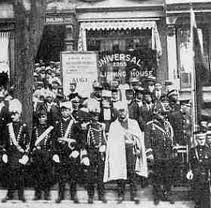
Strangely enough Garvey’s racial
approach of the world and religion leads him to alluding to the fact Jesus is
white and he rejects it with a strange argument saying that God created all men
equal in his own image, hence with no racial distinction or discrimination. He
suggests even that Jesus can be seen as the Son of God and thus belonging to
all humanity, to all races. He of course would reject the Mormon explanation
that the black race was created when Cain
was rejected by God and made black as a punishment for his crime. But then his
strong racial approach would imply Jesus belongs to all races, hence can be
seen as white, black or yellow, and this is a no-answer more than an answer. In
fact as we have seen in the objects of UNIA, culture is not taken into account.
Here we are dealing with a strong cultural element that is part of the African
heritage of the Black slaves. Africans are deeply committed to an animistic
vision of the world and life. This transcending vital force present in all
things is connected with a spiritual world beyond the surface of everyday
reality, and evil is not part of this energy but the fact of the existence of
bad spirits and ghosts who are the dead evil men: evil is brought into the
world by man himself. This deeply animistic vision was able to integrate the
Christian approach easily, in fact the Catholic approach, either French or
Spanish. They then became Christians or they developed an African religious
tradition, Vodun, in Louisiana and the West
Indies, with an extreme and morbid form in Haiti with the Tontons Macoutes of
late Duvallier Sr. Note this tradition goes far beyond the blacks since Anne
Rice for one example used it in one of her vampire books and Arthur Miller used
it in The Crucible. This deep
religious African heritage produced a vast Christian movement among American
Blacks that is present in the oration of all black public speakers of any type.
This too is a direct African heritage founded on the rhythmic experiential and
existential capture of life, in fact a polyrhythmic capture that is the other
enormous contribution of African heritage to American culture, and today global
culture. This again is missed by Garvey who does not consider culture as an
objective.
This religious tradition produced
the ideology of “the Everlasting Brotherhood of Man and the Eternal Fatherhood
of God.” There is no surprise in the total absence of women and the mother.
This is both African heritage and loss. Heritage in the capture of women as
being secondary, of society as being dominated by men, but loss in the absence
of the mother because the mother is the real source of the legitimacy of a
blood line and humanity. But his God has no motherly nor feminine dimension, in
pite ogf the fact that he says that God made two people in his image, Adam and
Eve.
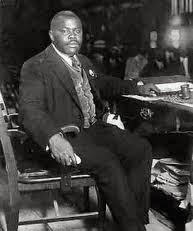
Then Marcus Garvey develops a
pan-African approach of his Africanism. The Blacks as a race must regain their
nation and that is Africa, seen and repeated as being a whole and integrating
all the Blacks in the world who have to return to Africa to take part in the “colonizing”
of Africa by the Africans. We have seen he
considers the Africans in Africa to be divided
in tribes within the African nation and these tribes are “backward.” But the
objective of reconstructing Africa when it is liberated from the colonizing
presence of the Europeans, is asserted over and over again and only one center
appears in this racial Africa: Ethiopia.
His dream of decolonizing Africa, the “dream
of an African empire” can go as far as supporting the German Dr Heinrich Schnee
who advocates that:
“America
[should] take over the mandatories of Great Britain
and France in Africa for the colonizing of American Negroes. . . . he
says: ‘As regards the attempt to colonize Africa
with the surplus American colored
population, this would in a long way settle the vexed problem . . . and
simultaneously ease the burden of German reparations which is paralyzing
economic life.’”
This Doctor Schnee suggests this
at a time when all German mandatories in Africa have been seized and shared
between England and France as war reparations: Cameroun was
even cut in two for that purpose. This support is surprising because how could
he trust, even very indirectly, the USA
to do a better job at colonizing Africa than the English or the French, and how
could he believe the USA would
only send their ex-slaves and their descendants to Africa
to do the job. American corporations would certainly think differently and
anyway that would have been at the time running against the “manifest destiny”
of the USA,
a conception that had already been trampled upon with the participation in the first
world war.

His dual vision of reality comes
from the radical opposition between the black race and the white race, the
oppressed and the oppressor, the master and his serf/peon/slave, the master
again and helpless imbeciles, dependent slaves and servants. Deeply inspired
,by slavery, its denunciation and the call to bring down all kinds of servitude
as he is, Garvey clearly describes the sufferings of black slaves and even of
the black victims of segregation, though he does not see how the colonists of
old turned Africans into slaves on the model of what Willie Lynch suggested and
he does not emphasize the resistance of the Africans withçn that frame of extreme
animalization and domestication of this American brand of slavery that had no
equivalent in the West Indies and in French or Spanish colonies in Louisiana
and central or south America. He also contains the germs of the two ways of
solving what comes from these slavery and segregation.
He of course does not call it
Post Traumatic Slave/Slavery Syndrome/Disorder as is done today. But he
contains the germs of the Muslim solution in the recapturing of the inner soul
and value of each black individual in the positive sides, actions and features
of his/her ancestors, including of course as slaves in the past, and
him/herself and his or her fellow blacks. He calls it pride and it is obvious
you cannot recapture your value if you do not reconstruct your personal
positive contribution to life, and that of your ancestors. This can only happen
within a collective organization and action, that will necessarily lead to the
shedding of some blood, of all blacks if possible.
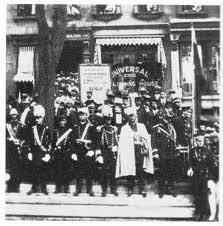
On the other side he is extremely
favorable to the direct accusation of the whites and the demand of the blacks
that the whites make amends and provide reparations. This is more in the line
of the traditional Black Christian approach that will be so well illustrated by
writers like Richard Wright, Ralph Ellison and James Baldwin, among others.
In other words Marcus Garvey in
this book appears as a conscious person who knows about the suffering of his
people, who knows that these people have to recapture power and control, but at
the same time he neglects the tremendous cultural and artistic contribution of
African heritage brought to American by the African slaves. Jazz was just in
the making with the development of the radio in the 1920s and jazz was and
still is a complete turn-around of history in which the slaves or ex-slaves
become the driving cultural force of the USA,
America
and the world. He seems to be conscious of the two approaches we can take as
for solving the black problem, though he does not clearly see that the
enslavement of the slaves was a lot more than just plain physical. It created a
lasting disorder in the psyche of the slaves and their descendents. But he is
trapped by his own radicalism that makes him declare when arrested: “The Negro
Ministry needs purging.” Such declarations could only lead to a de facto
convergence of action between the moderate black intellectuals and the white
police forces and establishment. This split between radicals controlling a mass
movement and moderates controlling the avenues of power no matter how small and
restricted will reproduce the structure of mental dependence long after the end
of slavery till it finally was identified as a Post Traumatic Stress Syndrome.
And even so, the Christian approach and the Muslim approach remain
differentiated. The divide has still not yet been bridged because of the strong
and deep survival of the dual vision of the world cut into two antagonistic
races, just the wame way as ideological and sectarian communism took a long
time to die because of the strong ideological survival of the dual vision of
society cut into two antagonistic classes, a vision that is still quite active
in the minds of many trade-unionists for example.

Duality is stagnation or aimless
erring in history and in any scientific project. Nothing is either A or B. it
has also to be seen as neither A nor B and as both A and B. The second formula
means that there is necessarily other solutions or protagonists than A and B.
Historically this volume is
essential. It contains the germs of the future and at the same time the
shackles that were to hamper the possible developments that were, still are
times and might very well be still in the future blocked by a reductive dual
antagonistic conception of the world and society. It takes a lot more than two
legs to walk with all kinds of sensors in the body, but anyway you need both
legs to simple put one foot in front of the other. Any pair of antagonistic
concepts are just doomed to fail explaining and predicting the past and the
future. That’s what I regret about this book, even if it was composed in 1923.
Dr Jacques COULARDEAU
EXPURGATED VERSION
FOR AMAZON PÖLITICALLY CORRECT BIGOTRY
This old book does not represent
a constructed and well balanced
presentation of Garvey’s ideas, but rather a selection of many small excerpts,
each one under s small title. Apart from some speeches at the end of the
volume, and we cannot say whether these speeches are unabridged or full,
everything else is tit bits of thinking in any haphazard jumble. We then have
to extract a philosophy out of this patchwork.
These documents all have a unity
in the fact that they are all from the Harlem
period in Marcus Garvey’s life. He arrived in Harlem in 1916, coming from Jamaica.
His problems with justice started as sson as 1922. He will find himself in
prison in 1926 and will be deported back to Jamaica in 1927. He founded with
some others the Universal N**** Improvement Association and organized the First
International Convention of the N**** Peoples of the World that lasted thirty
days in 1920 with a mass rally in Madison
Square Garden
that brought together more than 25,000 people. Internationally he arrived in
Harlem when the USA entered
the War in Europe and moved many blacks from
the south to the north to work in the war industry. Then this period
(1916-1922) covers the end the war and the great changes that occurred in the
world then and just after, particularly the Soviet revolution in 1917 that is
actually referred to in the volume as being led by Lenin and Trotsky.
This mention of Lenin and Trotsky
is important because the very first principle that emerges from this volume is
that he has recuperated his main central concept from the Marxist catechism
that was triumphing in Russia, and he has only replaced the word “class” in
“class struggle” by the word “race” to produce a vision of everything in the
world as being a “race struggle.”
For him there are three races.
·
The whites (this race is specified to be Europe and the west) who exploits the yellow and the
blacks.
·
The yellow (this race is specified only once to
be the Japanese) who exploit the blacks.
·
The blacks (this race is clearly identified as
the Africans and Africa with no distinction whatsoever between North Africa,
and Egypt is part of this Africa that covers all blacks in the world too and is
only identified several times as Ethiopia) who are exploited by everyone.
The blacks are simply confronted
to the simple choice:
1- recapture your autonomy
or
2- accept full extermination.
This choice carries in itself the answer. The problem then
is how is that recapture supposed to happen?
This first principle is extremely
radical and that will bring him a lot of hostility from the officials of the USA,
all white of course, and from the moderate Black leaders and intellectuals,
among whom W.E.B. DuBois is prominent. DuBois accuses him of being
“dictatorial, domineering, inordinately vain and very suspicious,” of having
“absolutely no business sense, no flair for real organization” and of only
having “objects . . . shot through with bombast and exaggeration.” This came shortly
after the period we are considering but is pretty final. Garvey explains this
hostility with jealousy because they are moderate and he is radical and what’s
more he has managed to build a mass movement.
The mass movement is UNIA and the
various branches and organizations he created around this movement: like the
African Legions and the Black Cross, service organizations for the Blacks, and
commercial ventures like the Black Star Line aiming at importing African
products to the USA and West Indies, and the N****es Factories Corporation to
develop Black business. In 1924, hence outside the period concerned here, he
specified the “Aims and Objects of Movement for Solution of N**** Problem,” as
the president of UNIA.
“The UNIA and African Communities’
League is a social, friendly, humanitarian, charitable, educational,
institutional, constructive and expansive society. . . [the aims are] to
establish a Universal Confraternity among the race; to promote the spirit of
pride and love; to reclaim the fallen; to administer to and assist the needy;
to assist in civilizing the backward tribes of Africa; to assist in the
development of Independent N**** Nations and Communities; to establish a
central nation for the race; to establish Commissionaries or Agencies in the
principal countries and cities of the world for the information of all N****es.”
This gives us some more organized
vision of Marcus Garvey’s thinking. The motto of UNIA is “One God! One aim! One
destiny!” that is a clear statement amplifying the quotation often attributed
to Garvey: “Up you mighty race, you can accomplish what you will.”
The first basic element after the
race struggle is the religious reference to and inspiration from Jesus. The
Jews are clearly and very emphatically accused of being responsible for the
crucifixion of Jesus. The ideal attributed to Jesus is systematically presented
in triads of terms like “a life of Love, Charity, Mercy.” “His innocence, His
Love and His Charity” are attributed to Jesus. Africa is reduced to “Egypt, Ethiopia
and Timbuktu.”
God is referred to as being “the Great Omnipotent, the Great Creator, our
Eternal Father.” Jesus is called “our Master, our prince of Peace, our
Redeemer.” He has “conquered death, the grave and hell.” Then “we sing and
shout with the angels, we ring our joy bells; we blow our horns.” These three
ways of sending a message with our voices, our bells and our horns are “in
praise” of Jesus who is “the Jesus, the Christ, the Emanuel to us,” a triad by
the form that is immediately amplified by to titles set apart by their form:
“the Son of Righteousness, the Prince of Peace.” Then the conclusion comes with
another triad that “shout[s] our praises to God for freedom, for liberty, for
life.” Some will say this triad is artificial since freedom and liberty are the
same thing. And yet, are they reality?
Strangely enough Garvey’s racial
approach of the world and religion leads him to alluding to the fact Jesus is
white and he rejects it with a strange argument saying that God created all men
equal in his own image, hence with no racial distinction or discrimination. He
suggests even that Jesus can be seen as the Son of God and thus belonging to
all humanity, to all races. He of course would reject the Mormon explanation
that the black race was created when Cain
was rejected by God and made black as a punishment for his crime. But then his
strong racial approach would imply Jesus belongs to all races, hence can be
seen as white, black or yellow, and this is a no-answer more than an answer. In
fact as we have seen in the objects of UNIA, culture is not taken into account.
Here we are dealing with a strong cultural element that is part of the African
heritage of the Black slaves. Africans are deeply committed to an animistic
vision of the world and life. This transcending vital force present in all
things is connected with a spiritual world beyond the surface of everyday
reality, and evil is not part of this energy but the fact of the existence of
bad spirits and ghosts who are the dead evil men: evil is brought into the
world by man himself. This deeply animistic vision was able to integrate the
Christian approach easily, in fact the Catholic approach, either French or
Spanish. They then became Christians or they developed an African religious
tradition, Vodun, in Louisiana and the West
Indies, with an extreme and morbid form in Haiti with the Tontons Macoutes of
late Duvallier Sr. Note this tradition goes far beyond the blacks since Anne
Rice for one example used it in one of her vampire books and Arthur Miller used
it in The Crucible. This deep
religious African heritage produced a vast Christian movement among American
Blacks that is present in the oration of all black public speakers of any type.
This too is a direct African heritage founded on the rhythmic experiential and
existential capture of life, in fact a polyrhythmic capture that is the other
enormous contribution of African heritage to American culture, and today global
culture. This again is missed by Garvey who does not consider culture as an
objective.
This religious tradition produced
the ideology of “the Everlasting Brotherhood of Man and the Eternal Fatherhood
of God.” There is no surprise in the total absence of women and the mother.
This is both African heritage and loss. Heritage in the capture of women as
being secondary, of society as being dominated by men, but loss in the absence
of the mother because the mother is the real source of the legitimacy of a
blood line and humanity. But his God has no motherly nor feminine dimension, in
pite ogf the fact that he says that God made two people in his image, Adam and
Eve.
Then Marcus Garvey develops a
pan-African approach of his Africanism. The Blacks as a race must regain their
nation and that is Africa, seen and repeated as being a whole and integrating
all the Blacks in the world who have to return to Africa to take part in the “colonizing”
of Africa by the Africans. We have seen he
considers the Africans in Africa to be divided
in tribes within the African nation and these tribes are “backward.” But the
objective of reconstructing Africa when it is liberated from the colonizing
presence of the Europeans, is asserted over and over again and only one center
appears in this racial Africa: Ethiopia.
His dream of decolonizing Africa, the “dream
of an African empire” can go as far as supporting the German Dr Heinrich Schnee
who advocates that:
“America
[should] take over the mandatories of Great Britain
and France in Africa for the colonizing of American N****es. . . . he
says: ‘As regards the attempt to colonize Africa
with the surplus American colored
population, this would in a long way settle the vexed problem . . . and
simultaneously ease the burden of German reparations which is paralyzing
economic life.’”
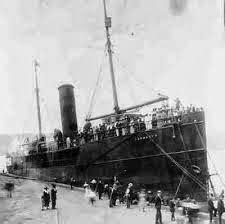
This Doctor Schnee suggests this
at a time when all German mandatories in Africa have been seized and shared
between England and France as war reparations: Cameroun was even cut in two for
that purpose. This support is surprising because how could he trust, even very
indirectly, the USA to do a
better job at colonizing Africa than the English or the French, and how could
he believe the USA would
only send their ex-slaves and their descendants to Africa
to do the job. American corporations would certainly think differently and
anyway that would have been at the time running against the “manifest destiny”
of the USA,
a conception that had already been trampled upon with the participation in the first
world war.
His dual vision of reality comes
from the radical opposition between the black race and the white race, the
oppressed and the oppressor, the master and his serf/peon/slave, the master
again and helpless imbeciles, dependent slaves and servants. Deeply inspired
,by slavery, its denunciation and the call to bring down all kinds of servitude
as he is, Garvey clearly describes the sufferings of black slaves and even of
the black victims of segregation, though he does not see how the colonists of
old turned Africans into slaves on the model of what Willie Lynch suggested and
he does not emphasize the resistance of the Africans withçn that frame of extreme
animalization and domestication of this American brand of slavery that had no
equivalent in the West Indies and in French or Spanish colonies in Louisiana
and central or south America. He also contains the germs of the two ways of
solving what comes from these slavery and segregation.
He of course does not call it
Post Traumatic Slave/Slavery Syndrome/Disorder as is done today. But he
contains the germs of the Muslim solution in the recapturing of the inner soul
and value of each black individual in the positive sides, actions and features
of his/her ancestors, including of course as slaves in the past, and
him/herself and his or her fellow blacks. He calls it pride and it is obvious
you cannot recapture your value if you do not reconstruct your personal
positive contribution to life, and that of your ancestors. This can only happen
within a collective organization and action, that will necessarily lead to the
shedding of some blood, of all blacks if possible.
On the other side he is extremely
favorable to the direct accusation of the whites and the demand of the blacks
that the whites make amends and provide reparations. This is more in the line
of the traditional Black Christian approach that will be so well illustrated by
writers like Richard Wright, Ralph Ellison and James Baldwin, among others.
In other words Marcus Garvey in
this book appears as a conscious person who knows about the suffering of his
people, who knows that these people have to recapture power and control, but at
the same time he neglects the tremendous cultural and artistic contribution of
African heritage brought to American by the African slaves. Jazz was just in
the making with the development of the radio in the 1920s and jazz was and
still is a complete turn-around of history in which the slaves or ex-slaves
become the driving cultural force of the USA,
America
and the world. He seems to be conscious of the two approaches we can take as
for solving the black problem, though he does not clearly see that the
enslavement of the slaves was a lot more than just plain physical. It created a
lasting disorder in the psyche of the slaves and their descendents. But he is
trapped by his own radicalism that makes him declare when arrested: “The N****
Ministry needs purging.” Such declarations could only lead to a de facto
convergence of action between the moderate black intellectuals and the white
police forces and establishment. This split between radicals controlling a mass
movement and moderates controlling the avenues of power no matter how small and
restricted will reproduce the structure of mental dependence long after the end
of slavery till it finally was identified as a Post Traumatic Stress Syndrome.
And even so, the Christian approach and the Muslim approach remain
differentiated. The divide has still not yet been bridged because of the strong
and deep survival of the dual vision of the world cut into two antagonistic
races, just the wame way as ideological and sectarian communism took a long
time to die because of the strong ideological survival of the dual vision of
society cut into two antagonistic classes, a vision that is still quite active
in the minds of many trade-unionists for example.
Duality is stagnation or aimless
erring in history and in any scientific project. Nothing is either A or B. it
has also to be seen as neither A nor B and as both A and B. The second formula
means that there is necessarily other solutions or protagonists than A and B.
Historically this volume is
essential. It contains the germs of the future and at the same time the
shackles that were to hamper the possible developments that were, still are
times and might very well be still in the future blocked by a reductive dual
antagonistic conception of the world and society. It takes a lot more than two
legs to walk with all kinds of sensors in the body, but anyway you need both
legs to simple put one foot in front of the other. Any pair of antagonistic
concepts are just doomed to fail explaining and predicting the past and the
future. That’s what I regret about this book, even if it was composed in 1923.
Dr Jacques COULARDEAU
# posted by Dr. Jacques COULARDEAU @ 4:50 AM
0 comments

DEXTER – EIGHTH AND FINAL SEASON – 2013
To wrap up the story in twelve
episodes or chapters, that’s short, that’s fast, but that’s radical, à la
Dexter. He manages to solve a ton of problems in these twelve episodes.
First he finds a surrogate mother
for Harrison, and that was difficult to find. Luckily
the only woman he had loved and that was still alive, apart from his sister turns
up and re-activates some fundamental mechanisms. And Harrison
likes her. She is very special but she wants to become a good girl.
He manages to solve the problem
of his father and how his father, a good cop, could accept his adoptive son to
become a criminal, how he managed to come up with the code, etc. In fact the
symbolical mother surrogate of his, of Dexter, comes up to him and reveals who
she is and what she did. She reveals that his father OD’ed on his heart drug
when he could not stand what Dexter had become any more. Dexter hates that
doctor Vogel that has nothing of a bird in that story, at most a vulture but
that is no bird you try to attract in
your garden with a bird feed and a bird bath.
He has to solve a last case of a
serial killer who is aiming at both him and Doctor Vogel. Her past is revealed
and she becomes extremely dark and deep with one son killed by another, you
know the story of Cain and Abel. And the killing son is sent East of Eden in
some institution in England,
or something far to the East. And there he is tortured into medical blankness
since he is a criminal who deserves to be punished even if it is with drugs or
some archaic violent treatment like electric shocks or other forceful
manipulations of the body or the brain, and why not the mind and the imagination.

Of course the dear son who was
buried alive in this institution plans a good case of arson, with seven dead
people in the wing that burns, and himself among these seven, officially, because’
in fact he manages to get out, change identities and then move on, looking for mummy,
Doctor Vogel, and all those she preferred to him, and first of all Dexter. And
the blood trail can start under the police identity of the “brain surgeon”
because he saws up the skull of his victim in a very special way and scoops out
one very precise section of the brain and delivers these extracted sections to
his mummy. A yummy appetizer for Christmas dinner or Thanksgiving celebrations.
He of course has to save his sister
from private investigation and then to make her a star in the Police
Department. So he finally comes over his need to kill with his last victim and
gives him over to Deborah for her to arrest him. But a Federal Marshall comes
up and he completely messes the case, frees the criminal who kills him straight
away, takes his gun, shoots Deborah who shoots him but in vain. And things will
not turn honky dory and there will be some complications. Dexter then has to
close up the file and clean up the plate. Deborah disappears in a hurricane.
Finally he has to take care of
himself and to protect Harrison and the substitute mother who has taken the boy
to South America, and there is only one way. So
he disappears with his boat into the hurricane. A tempestuous ending but it
works.
And yet they more or less kept one
card up their sleeves, I mean the producers, for a sequel in let’s say five or
ten years, when Harrison reaches teenage and starts moving towards finding his
father and recuperating the father model he needs and remembers from his
tumultuous first four years. Check it all by yourselves with the DVDs how they
manage to keep one bun in the oven in slow gestation.
You can always dream. But it is
sure the author of the book series will be able to go on working with Dexter if
he wants, though the last volume was announced a long time ago and will maybe
finally come out next March (2014) and it is supposed to be entitled Dexter’s Final Cut, which promises quite
some blood.
We’ll see. Que sera sera. Will I be pretty? Will I be rich? What will
be, will be!
Dr Jacques COULARDEAU
# posted by Dr. Jacques COULARDEAU @ 3:26 PM
0 comments




































